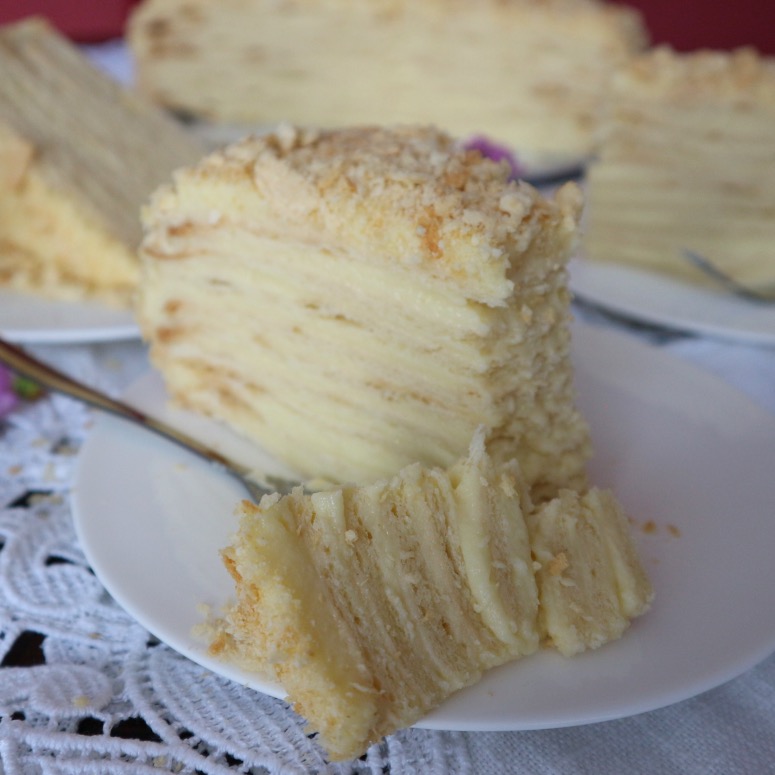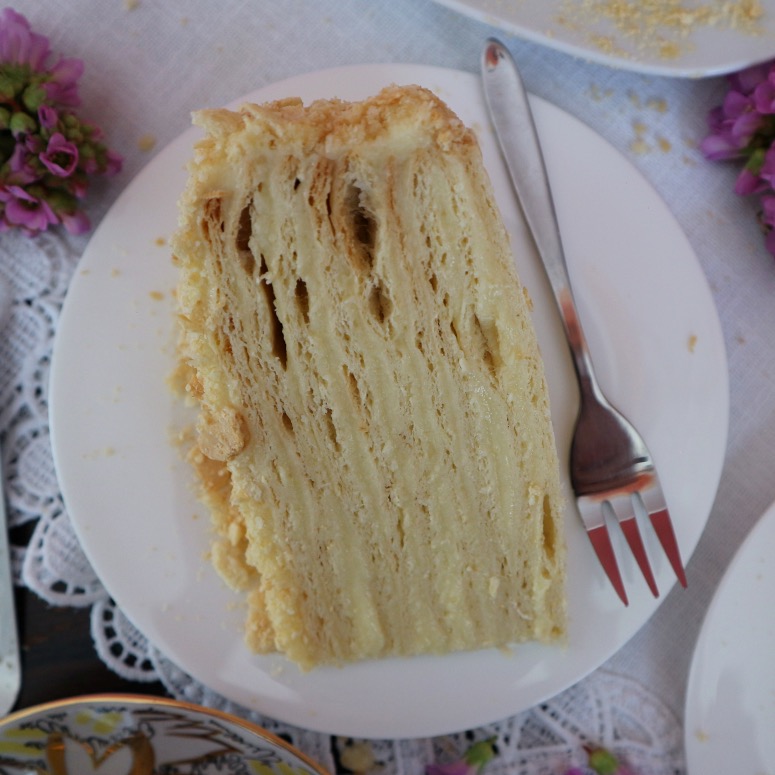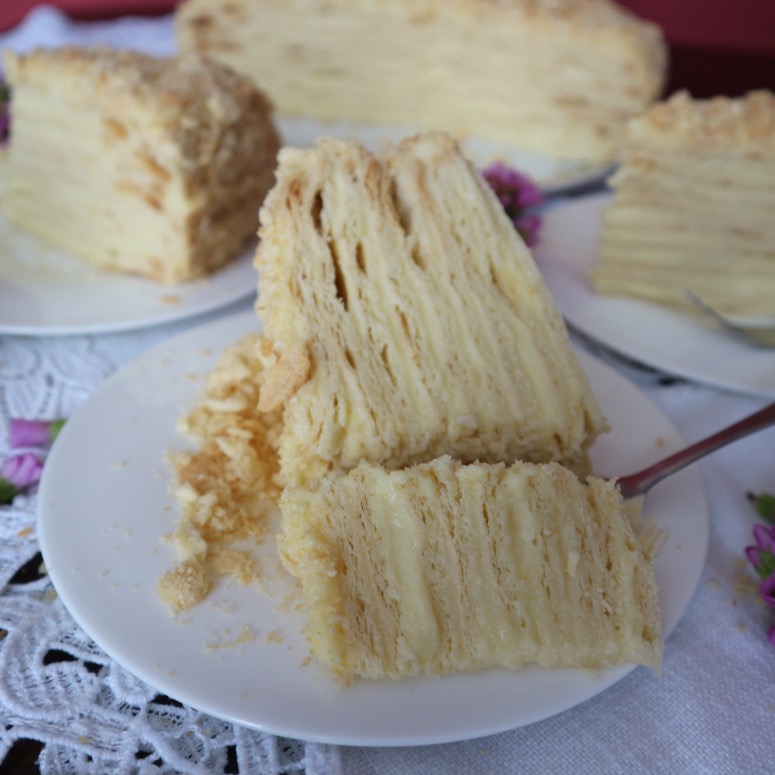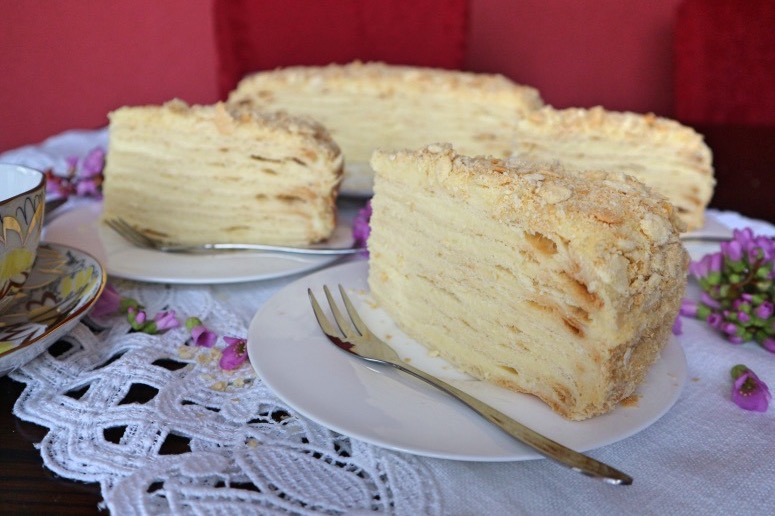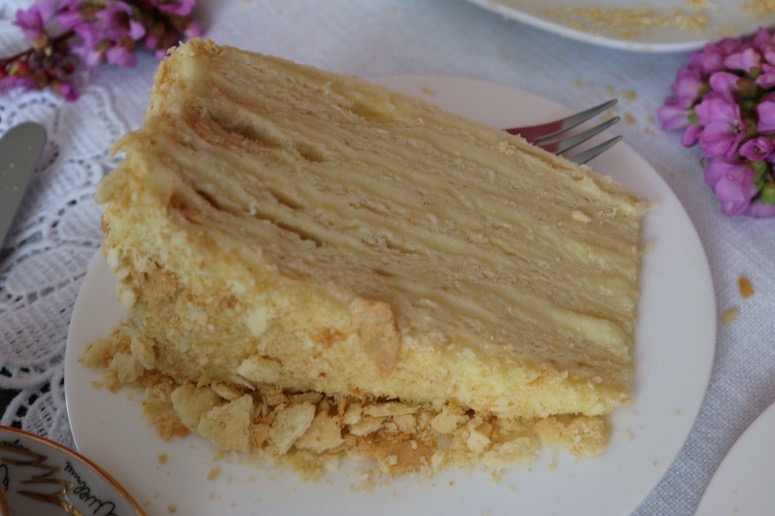Dieser Beitrag ist auch verfügbar auf:
Deutsch
Crispy puff pastry and delicate vanilla pudding cream – a heavenly delicious combination, which makes the Russian Napoleon cake. It tastes creamy, airy, not too sweet and is very aromatic.
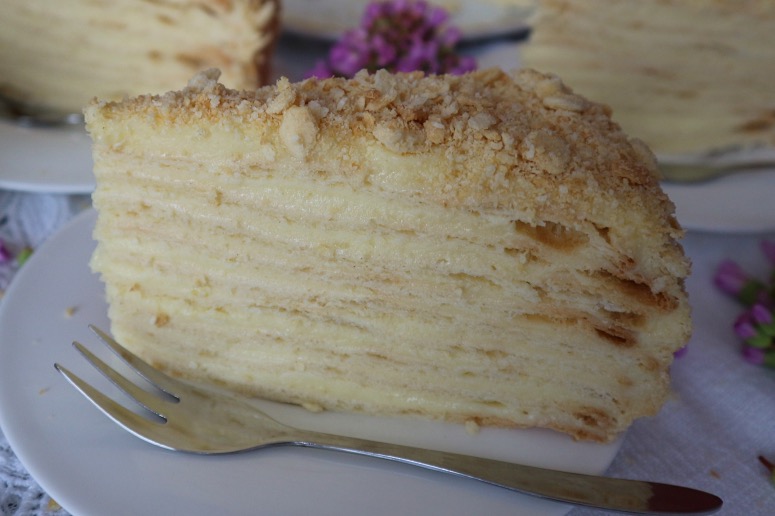
It’s not without reason that Napoleon cake is one of the most popular Russian cakes – and has been for ages. Here I show you how to make the classic Napoleon cake yourself. A detailed recipe for the Russian Napoleon cake with exact quantities and step-by-step instructions can be found here at the bottom.
Napoleon cake: very popular not only in Russia
Napoleon cake was very popular in the Soviet Union and is still one of the most famous cakes in Russia. For many who grew up in the Soviet era, Napoleon cake is the “taste of their childhood”. Especially on the Christmas table it can not be missing in Russia.
Where the recipe for the cake originally came from is not so clear. There are some stories about it. While in Russia especially the Napoleon cake and tartlets with vanilla pudding cream or with buttercream are very common, there are similar cakes with puff pastry in other countries.
In France and Italy, for example, the cake is called mille-feuilles. It is prepared in the same way with puff pastry, but differs from the Russian version in the cream, which is mainly jam or cream.
Effort for the preparation is worth it
Along with Medovik honey cake, Napoleon cake is one of the most delicious Russian cakes. Once you’ve tried it, you’re sure to be just as delighted with it.
So the effort to prepare Napoleon cake is definitely worth it. The recipe for it is also not that difficult. Only enough time should be planned for the DIY of the cake. Because for the rolling out and baking of the many cake layers you need some patience.
Serve and store Napoleon cake
The Russian Napoleon cake tastes best the next day. So prepare it a day before serving. If you want to serve the cake on the same day you made it, let it stand in the refrigerator for at least 6 hours after preparation. In that time, all the ingredients will be able to combine tastefully.
Russian Napoleon cake is ideal for dessert at the weekend or during the week, for example, with coffee and tea. In Russia, people like to serve it at various festivities. No wonder, because the layer cake not only tastes very delicious, but is an eye-catcher on the dining table.
Especially at Christmas it is a must. You can also give the Napoleon cake for a birthday, Mother’s Day or Easter.
Keep the Napoleon cake in the refrigerator. You can enjoy it for about 5 days. It tastes just as delicious during the days as it does the next day after preparation – or even better.
The cake Napoleon is
- tender,
- creamy,
- crispy,
- airy,
- not too sweet,
- heavenly delicious,
- very aromatic,
- with homemade puff pastry,
- with vanilla pudding cream,
- with many thin layers,
- even more delicious in the next few days,
- an eye-catcher on the dining table,
- homemade from ordinary ingredients,
- ideal for dessert during the week or for a party,
- perfect for Christmas or Easter,
- about Ø 24 cm big,
- a classic of Russian cuisine.
Russian Napoleon cake: classic recipe
You can find the exact quantities and step-by-step instructions for making the Russian Napoleon cake yourself below in the box recipe.
For both the puff pastry and the vanilla pudding cream, you’ll only need common ingredients that you may already have at home. The preparation of the cake is a bit time-consuming, but it is worth it.
For the pastry you need
- cold butter,
- cold water,
- flour,
- egg
- and baking powder.
It is important that the ingredients for the dough are cold, so that it becomes flaky after baking. For this, it is best to put the butter in the freezer before using it, the egg in the fridge, and put the water in the fridge as well.
For the cream you need
- milk,
- butter,
- eggs,
- sugar,
- flour
- and vanilla.
So that you succeed the cream, note my tips and tricks here below.
How to make Napoleon cake: this is how it works
- For the dough, mix flour with baking powder, add cold butter and chop finely. Add egg and cold water and knead it briskly into a soft dough. Divide the dough into 9 pieces and chill for 1.5 – 2 hours. Then roll out each piece thinly into a circle, bake at 210 °C for about 5 – 7 minutes each and let cool. Also roll out the leftover dough, bake and crumble.
- For the cream, mix eggs and flour. Put milk and sugar in a saucepan, heat, remove from heat and slowly stir in the egg-flour mixture. Then simmer the mixture for 1 – 2 minutes until it reaches a pudding-like consistency, and let it cool to room temperature. Add softened butter and vanilla and mix to a homogeneous cream.
- Spread the cream on the cake layers and stack them on top of each other. Sprinkle the cake with the crumbs and chill for about 8 hours. The classic Napoleon cake is ready!
Russian layer cake: with these tips and tricks you will succeed perfectly
- It is important that butter for Napoleon dough is cold, so that the dough ends up flaky. You can put it in the freezer about 20 – 30 minutes before. Water and egg for the dough must also be cold.
- To finely chop butter in flour, you can simply grate it coarsely. Roll the butter in the flour again and again and stir the flour with the already grated butter regularly. Then it will not melt so quickly. To mix the butter with the flour, use a dough scraper instead of your hands. If you do it with your hands, the butter will melt and the dough will end up less flaky.
- Margarine works instead of butter. It’s best to use organic margarine.
- If your dough is too dry when kneading, add some more cold water. If the dough is too sticky, add some flour.
- Do not knead the dough too long. It is sufficient to work it quickly into a roughly homogeneous mass. Then the cake layers will taste really flaky in the end.
- Be sure to leave the dough in the refrigerator for 1.5 – 2 hours.
- While the dough is chilling, you can cook the custard for the cream and let it cool.
- Take each piece of dough out of the fridge one at a time right before rolling out, and leave the rest in the fridge while you work with one to keep them cold.
- The best way to cut out round cake layers is to first roll out each piece of dough into a rough circle that is slightly larger than 24 cm in diameter, then place an approximately Ø 24 cm plate or the bottom of a baking springform pan on top and cut out a circle around the plate or the baking springform pan bottom with a sharp knife. Use the leftover dough for the crumbs.
- While the first cake layer is baking, roll out the second one, bake it right after the first one, and meanwhile roll out the third cake layer, and so on. Do not leave both the dough and the unrolled, unbaked pie crusts at room temperature for too long. To make the dough flaky after baking, do not let the butter in the dough melt before baking.
- I had 9 about Ø 24 cm pie crusts rolled out of the dough and baked. You can of course roll out more or less and accordingly smaller or larger pie crusts.
- Piercing each cake layer with a fork before baking ensures that no large bubbles appear on the cake layers during baking.
- Carefully remove the hot cake layers from the baking sheet immediately after baking, as they are very crumbly.
- Instead of flour, you can use cornstarch for the cream.
- It is important that the egg-flour mixture for the cake cream does not contain any lumps when you add it to the hot milk. So stir it thoroughly beforehand, for example with a whisk.
- Add the egg-flour mixture to the hot milk very slowly, in a thin stream, and be sure to stir constantly.
- Cook the custard in a stainless steel saucepan with a thick bottom so that it does not burn.
- Stir the custard for the cream thoroughly as it cooks, or lumps may form.
- Vanilla is added to the custard after cooking to preserve the flavor.
- You can use vanilla sugar, vanilla powder, vanilla extract or vanilla bean scraped out as vanilla, for example.
- The custard for the cream should be stirred occasionally as it cools to prevent a film from forming on the surface.
- Both the custard and the butter for the cream need to be room warm when you mix them together so that they can combine well into a homogeneous cream.
- The pudding mixture and the butter for the cream must only be stirred together (until a homogeneous mixture is formed) and not whipped.
- Simply store the Napoleon cake on a flat plate or large cutting board in the refrigerator. It will keep for about 5 days.
- The Napoleon cake will taste even better the next day.
Video for the Napoleon cake recipe
By the way, on my Youtube channel you can find a short video for the Russian Napoleon cake. There you can see exactly how to make it yourself, including how to prepare the dough, and what consistency the cream should have. If you don’t want to miss any more videos from me, feel free to subscribe to my channel.
Did you make the Russian Napoleon cake with this recipe? I’m looking forward to your result, your star rating and your comment below, how you liked the Napoleon cake.
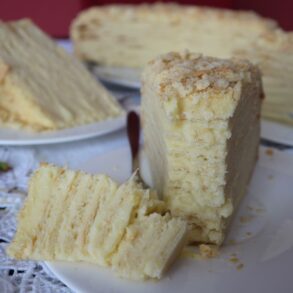
Russian Napoleon cake
Ingredients
for the dough
- 250 g butter (cold)
- 1 egg (cold)
- 200 ml cold water
- approx. 520 g flour
- 10 g baking powder
- 1 pinch of salt
- flour for the work surface
for the cream
- 1 l milk
- 170 g butter (room temperature)
- 300 g sugar
- 4 eggs
- 60 g flour
- vanilla
Instructions
Preparation of the dough
- Mix flour with baking powder and salt. Add cold butter and chop it finely.
- Add egg and cold water and knead it quickly to a soft, only roughly homogeneous dough. (Note the tips and tricks at the top of the post for this).
- Divide the dough into 9 equal pieces, spread them on a plate or cutting board, cover and chill for 1.5 - 2 hours.
- Then roll out each piece of dough thinly on a sheet of baking paper lined with baking paper and dusted a little with flour, and cut out a circle of about Ø 24 cm from each rolled-out piece of dough. While you are working with one piece of dough, leave the others in the refrigerator. (Note the tips and tricks for this at the top of the post).
- Prick each dough circle several times with a fork and bake the dough circles one by one on the same sheet of baking paper on which they were rolled out, on a baking sheet in a preheated oven at 210 °C for about 5 - 7 minutes each, until they turn a light golden brown color. Let the cake layers cool down afterwards.
- Roll out all the leftover dough from cutting out the circles thinly into a pastry sheet, bake it just like the pie crusts, let it cool, and crumble it.
Preparation of the cream
- Mix eggs and flour until a homogeneous mass without lumps.
- Put milk and sugar in a thick-bottomed saucepan, put it on the stove and heat it, stirring, until the sugar is melted and the milk is just before boiling.
- Take the saucepan with the hot milk off the heat and immediately add the egg-flour mixture in a thin stream, stirring constantly.
- Place the saucepan back on the stove, bring the mixture to a boil over medium heat, stirring constantly, and then cook, stirring, for 1 - 2 minutes until it reaches a custard-like consistency. Take the pudding mixture off the heat and let it cool to room temperature, stirring occasionally.
- Add vanilla and soft butter cut into pieces to the pudding mixture and mix until it becomes a homogeneous cream.
Preparation of the Napoleon cake
- Spread each cake layer with the cream and stack the cake layers on top of each other.
- Brush the edges of the cake with the leftover cream and sprinkle the top and edges with the crumbs. Refrigerate the Napoleon cake for about 8 hours or overnight.
Notes
- It is important that butter for the Napoleon dough is cold, so that the dough ends up flaky. Water and egg for the dough must also be cold.
- If the dough is too dry when kneaded, add some more cold water. If the dough is too sticky, then add some flour.
- Do not knead the dough for too long. It is quite sufficient to quickly knead it into a roughly homogeneous mass. Then the cake layers will taste really flaky in the end.
- Take each piece of dough out of the fridge individually right before rolling it out, and leave the rest in the fridge as long as one is being worked with.
- While the first pie crust is baking, roll out the second, bake it right after the first, and meanwhile roll out the third pie crust, and so on. Do not leave both the dough and the unrolled, unbaked pie crusts at room temperature for too long. To make the dough flaky after baking, do not let the butter in the dough melt before baking.
- Instead of flour, use cornstarch for the cream.
- The egg-flour mixture for the cake cream must not contain lumps when added to the hot milk.
- Add the egg-flour mixture to the hot milk very slowly, in a thin stream, and be sure to stir constantly.
- Stir the custard mixture for the cream thoroughly as it cooks, otherwise lumps may form.
- Both the custard and the butter for the cream must be as warm as room temperature when stirred together to combine well into a homogeneous cream.
- Note the detailed tips and tricks for DIY Russian Napoleon cake at the top of the post.

